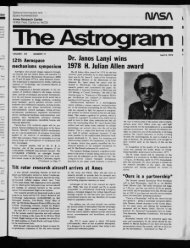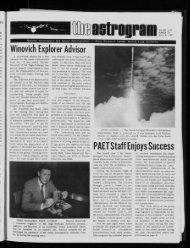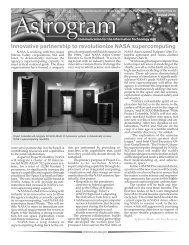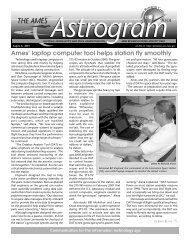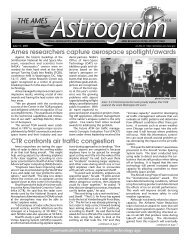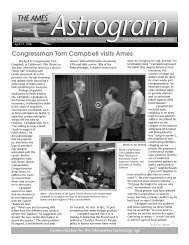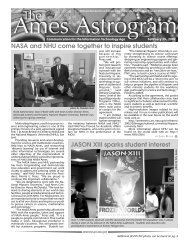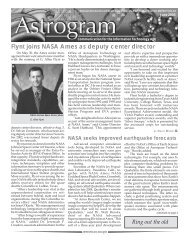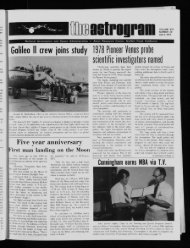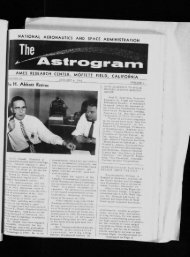3/12/01 Astrogram - NASA Ames History Office
3/12/01 Astrogram - NASA Ames History Office
3/12/01 Astrogram - NASA Ames History Office
Create successful ePaper yourself
Turn your PDF publications into a flip-book with our unique Google optimized e-Paper software.
Computer Technology<br />
IPG team reaches large-scale computer milestone<br />
<strong>NASA</strong>’s Information Power Grid (IPG)<br />
team achieved a major milestone at the end<br />
of December with the successful integrating<br />
of the updated SGI Origin 2000, Lomax,<br />
into the grid’s infrastructure. Lomax, with<br />
5<strong>12</strong> processors running at 400 megahertz<br />
each, is the second large-scale machine to<br />
be incorporated into <strong>NASA</strong>’s IPG. After integrating<br />
Lomax into the IPG production<br />
environment, the team was able to demonstrate<br />
its capabilities in conjunction with<br />
two other distributed IPG resources (one<br />
each at <strong>NASA</strong>’s Langley and Glenn Research<br />
Centers), to solve a multi-part aerospace<br />
research problem (see figure).<br />
IPG resources Sharp, a 24-processor SGI<br />
Origin 2000 at Glenn Research Center in<br />
Ohio, and Whitcomb, an 8-processor SGI<br />
Origin 2000 at Langley Research Center in<br />
Virginia, were used in concert with Lomax<br />
to solve complex aerospace geometries.<br />
The configurations were calculated using<br />
the computer code OVERFLOW, version D<br />
(see sidebar). This particular version of OVER-<br />
FLOW is designed specifically to take advantage<br />
of parallel and distributed computing<br />
resources by limiting the number of<br />
processors that can be used at any one time.<br />
Using a small number of processors on<br />
three distributed machines is an effective<br />
application of under-utilized resources. Using<br />
several grid resources for a job reduces<br />
turnaround time and creates a distributed,<br />
collaborative problem-solving environment.<br />
This approach to computing is also more<br />
cost-effective.<br />
“This will enable us to calculate a complex<br />
aerospace problem much faster by<br />
using all three of the machines,” explains<br />
Arsi Vaziri, IPG deputy project manager.<br />
Data is important too…in addition to<br />
demonstrating integration of a large<br />
supercomputer into the IPG structure, this<br />
milestone illustrates the importance of data<br />
transfer between remote resources.<br />
“Our approach to the IPG is geared<br />
toward an equal emphasis on data transmission<br />
and computational speed,” explains<br />
Vaziri. Many of <strong>NASA</strong>’s newer research<br />
programs rely heavily on cross-center collaboration<br />
and IPG provides an economical<br />
method for sharing data between colleagues<br />
at remote locations.<br />
“Agency-wide programs like ISE (intelligent<br />
synthesis environment) are essentially<br />
advanced design, or computer design<br />
projects for <strong>NASA</strong>’s aerospace enterprise,<br />
and that’s what we’re targeting--a computing<br />
environment that enables application<br />
domains to work with a large collection of<br />
machines, including supercomputers,” ex-<br />
plains Bill Johnston, IPG project manager.<br />
The Globus middleware package,<br />
designed to enable different types of<br />
IPG resources to interface with each<br />
other, was installed on Lomax with very<br />
few software changes.<br />
“Globus enables the IPG team to<br />
run easily any computational code and<br />
transfer data between Lomax, Sharp<br />
and Whitcomb,” explains Johnston.<br />
In addition to having the ability to<br />
transfer code and data easily, IPG users<br />
now have a collection of distributed<br />
resources, located at the three <strong>NASA</strong><br />
centers, to reduce end-to-end turnaround<br />
time for aerospace design and<br />
simulation problems. The next milestone,<br />
scheduled to be met in September<br />
20<strong>01</strong>, will incorporate an electron<br />
microscope located at the University of<br />
California at San Diego into the grid’s<br />
infrastructure to facilitate experiments requiring<br />
high data-transfer rates using the<br />
One of the large-scale OVERFLOW applications<br />
the IPG team used to demonstrate<br />
the successful completion of the December<br />
milestone was a Navier-Stokes computational<br />
fluid dynamics (CFD) simulation<br />
of flow about a generic reusable launch<br />
vehicle. The simulation was run using a<br />
distributed version of OVERFLOW, version<br />
D, which required 215 grids, or computational<br />
meshes and about 14 million grid<br />
points (see figure below). Without OVER-<br />
FLOW-D, this application could not have<br />
been run on multiple machines. Running<br />
this aerospace configuration with the recently<br />
integrated 5<strong>12</strong>-processor Origin<br />
Wind tunnel flow simulation of a wing-body<br />
model encompassing 32 zones and 9 million grid<br />
points.<br />
IPG provides aggregated computing in a parallel<br />
and distributed fashion. The grid can effectively use<br />
underutilized resources, decrease computational<br />
turnaround time, support a collaborative problemsolving<br />
environment, and provide more costeffective<br />
computing solutions<br />
IPG’s high-performance computing systems.<br />
OVERFLOW IPG applications<br />
BY HOLLY A. AMUNDSON<br />
2000 verifies that the IPG is a true application<br />
environment.<br />
The team also used a wind tunnel<br />
flow simulation of a high-lift wing configuration,<br />
which required 32 computational<br />
grids and nearly nine million grid<br />
points. (See figure below). This type of<br />
high-fidelity CFD code provides significant<br />
gains for the aerospace industry by<br />
reducing design-cycle time.<br />
Visualization of a generic reusable launch<br />
vehicle X-38 flow simulation — 215 zones<br />
and 14 million points.<br />
6 — The <strong>Ames</strong> <strong>Astrogram</strong> March <strong>12</strong>, 20<strong>01</strong>



